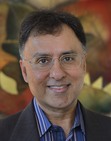Seeing the Oneness of our Reality – Part Four
This is Part Four of a Five Part Series of Seeing the Oneness of our Reality. See previous installments: Part One, Part Two, Part Three.
In this five part series, we will explore the meaning of Oneness – the concept of one interconnected consciousness that gives rise to all beings and matter. There is no self and the other, they are one and the same. In my opinion, it is the understanding and experience of Oneness that is the key ingredient necessary for us to progress forward as individuals and for society to solve its biggest problems. Think about it, progress on any of the major issues we face – rising poverty, food and water shortages, climate change, rising energy prices, growing inequality, deteriorating education standards, immigration etc – are all stale-mated at the current time because we have become hyper-polarized as a society in terms of us versus them, what’s mine is not yours, and winning is everything. Yet, collectively, we have enormous technology, intellectual, and financial resources to solve or at least significantly mitigate almost any problem, if we would only cooperate. But if we think we are separate and different from “the other person or group”, that cooperation will be a long time in coming, if ever. In this five-part series, I’ll take you on a tour of what the latest information form the world of Science, Spirituality, and Psychology is revealing about our true reality. These things have been spoken about by ancient spiritual traditions for thousands of years, but our modern world took a detour around 400 years ago and is now finally catching up. Hopefully more will awaken to our underlying interconnected and shared reality and we can finally move forward to realize our true potential. -JK
Part Four
“Channeled” communication coming from
the Universal Consciousness or Source
Up until now, we’ve seen examples of a life beyond the physical from science, historic spiritual teachings, and recorded instances of past life regressions and near-death experiences. If we can communicate via our thoughts in this world and our souls are reborn and live forever, it would not be a stretch of the imagination for people to receive communication from the spirit world as well, would it? As we’ve mentioned earlier, the Universal Consciousness is broadcasting 24/7/365—and the reality is, some people choose to tune in and listen.
Artists, musicians, and other creative people over the years have spoken of “divine inspiration” guiding their work. Others have spoken about “guardian angels” guiding them at key moments in their lives. We also now have examples where someone has received sustained communication or dialogue from the Source, or God. Neale Donald Walsch’s Conversations with God series is a well-known example.
Neale himself likes to quote the old axiom:
“When the student is ready, the teacher will appear.”
In his first text, which appeared in 1995, Neale began a conversation with God. As in so many cases, upon reaching rock bottom, Neale was now ready to listen and started to ask questions of the Source. God provided answers through Neale to some of the key questions we all have regarding our existence. Over the next ten years, he published three volumes of these dialogues. A text is available that contains all three books—you won’t want to put it down once you start reading.
Another profound example can be seen in Rasha, a singer residing in the South East living a common suburban lifestyle and experiencing all of life’s ups and downs. In 1987 she started to receive a sustained stream of messages from the Source about the nature of existence and the problem of not seeing clearly the unified nature of our reality with our fellow beings. She had her first active dialogue in 1998 and describes that first communication in the introduction to her book, Oneness:
“What is Oneness?” I asked silently. “Are you God?” “As the drop of water is to the ocean—that is what Oneness is. The essence of the drop is every bit the essence of the totality. As you would understand God to be—yes, we are God.”
Rasha goes on to describe some of the early teachings she received:
…the teachings of Oneness began to lay the foundations for seeing everything in our present-day world from the timeless perspective of energy. Oneness explained that the vibrational momentum driving all Creation toward unity is the same momentum that people everywhere are experiencing in their daily lives … I came to understand the dynamics of how we manifest our reality, vibrationally, and how our emotional response mechanism sets up the parameters for drawing our life experiences to us.
Sound familiar? You have to hand it to the Source—he (or she) is quite consistent! But perhaps the most intriguing channeled communication has come to us from Jesus himself. A Course in Miracles is a text that was transcribed by Helen Schucman, a Professor of Medical Psychology at Columbia University’s College of Physicians and Surgeons, first published in 1976. Helen describes herself in the introduction:
Psychologist, educator, conservative in theory and atheistic in belief, I was working in a prestigious and highly academic setting … Three startling months preceded the actual writing, during which time Bill [her co-author and academic peer], suggested that I write down the highly symbolic dreams and descriptions of the strange images that were coming to me. Although I had grown more accustomed to the unexpected by that time, I was still very surprised when I wrote, “This is a course in miracles.” That was my introduction to the Voice. It made no sound, but seemed to be giving me a kind of rapid, inner dictation which I took down in a shorthand notebook. The course states that “universal theology is impossible, but a universal experience is not only possible but necessary.” Although Christian in statement, the Course deals with universal spiritual themes. It emphasizes that it is but one version of the universal curriculum. There are many others, this one differing from them only in form. They all lead to God in the end.
So what we have is Jesus choosing an academic atheist to be his vessel to clarify and amplify his thoughts on human existence that he believes we haven’t quite grasped yet. It’s a brilliant choice—an atheist (disallowing us to easily say this is a true believer trying to get the message out) and an academic psychologist, well versed in the ways of the mind and how to communicate thoughts effectively.
When you read A Course in Miracles, you will be struck by the similarity to the topics we’ve discussed in this section. Let’s take a look at some of the teachings to illustrate the point:
The world we see merely reflects our own internal frame of reference—the dominant ideas, wishes, and emotions
in our minds.
Perception is a function of the body, and therefore represents a limit on awareness. Perception sees through the body’s eyes and hears through the body’s ears. It evokes the limited responses that the body makes. The body appears to be largely self-motivated and independent, yet it actually responds only to the intentions of the mind. If the mind wants to use it for attack (against fellow beings), it becomes prey to sickness, age, and decay.
The opposite of seeing through the body’s eyes is the vision of Christ, which reflects strength rather than weakness, unity rather than separation, and love rather than fear. The opposite of hearing through the body’s ears is communication through the Voice for God, the Holy Spirit ( The Field ), which abides in each of us. His voice seems distant and difficult to hear because the ego, which speaks for the little, separated self, seems to be much louder. (Duality between the Self and the Universal Consciousness )
Sin is defined as “lack of love.” Since love is all there is, sin in the sight of the Holy Spirit is a mistake to be corrected, rather than an evil to be punished.
Miracles are thoughts. Thoughts can represent the lower or bodily level of experience, or the higher or spiritual level of experience. One makes the physical, and the other creates the spiritual. ( Our thoughts create the world .)
If you’ve ever had some reservations about traditional Christian theology as it relates to what your life experience has been or are more attracted to recent teachings of the historical Jesus, give A Course in Miracles a try. Throughout the text, Jesus as channeled through Helen Schucman, attempts to clarify and correct aspects of Biblical teachings that may have been misunderstood—and to unveil teachings that were his original intent. (As an example, the belief in reincarnation was originally part of Christian doctrine. Roman Emperor Justinian had it removed from church doctrine in 553 A.D. in order to better control his subjects.)
Walter Semkiw, author of Born Again, has catalogued some of the beliefs that existed prior to that removal and found that a number of Christian Church Fathers believed in and wrote about reincarnation:
St. Justin Martyr (100–165 A.D.) expressly stated that the soul inhabits more than one human body.
Origen (185–254 A.D.), who was considered by St. Jerome as “the greatest teacher of the Church after the Apostles,” defended the idea that the soul exists before the body, fundamental to the concept of reincarnation.
Another Church Father, St. Gregory, Bishop of Nyssa (257–332 A.D.), wrote: “It is absolutely necessary that the soul should be healed and purified, and if this does not take place during its life on earth, it must be accomplished in future lives … The soul … is immaterial and invisible in nature, it at one time puts off one body … and exchanges it for a second.”
St. Gregory also wrote: “Every soul comes into this world strengthened by the victories or weakened by the defeats of its previous life.”
St. Augustine (354–430 A.D.), one of the greatest theologians of the Christian church, speculated that philosopher Plotinus was the reincarnation of Plato. St. Augustine wrote: “The message of Plato … now shines forth mainly in Plotinus, a Platonist so like his master that one would think … that Plato is born again in Plotinus.”
Walter summarizes his research by saying:
In sum, reincarnation has appeared in Christian church doctrine, but reincarnation has been suppressed in the contemporary Church’s philosophy. One reason is that if reincarnation is acknowledged and research demonstrates that souls can change religion from one incarnation to another, a religion’s claim to exclusive truth is negated. Still, evidence of reincarnation can help fulfill one of Christianity’s greatest doctrines, that we are indeed brothers and sisters, and that we should love one another as such.
You may also want to take a look at Marianne Williamson’s book, A Return to Love, Reflections on the Principles of a Course in Miracles. Marianne has become a well-known teacher of A Course in Miracles, and her book is a great user-friendly introduction to the principles in the text.
~Jay Kshatri
The post Seeing the Oneness of our Reality – Part Four appeared first on Think Smarter World.




